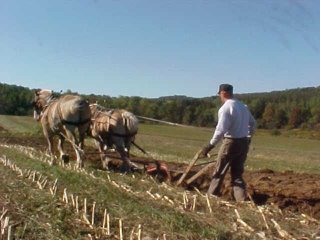 Some traditionalist Catholic bloggers want to remove themselves from the city to an agrarian life, including Fr. Lawrence Smith who was interviewed recently by Stephen L.M. Heiner. Fr. Smith has chosen to live near a very small community in Wisconsin because he believes city life is not conducive to Catholicism and:
Some traditionalist Catholic bloggers want to remove themselves from the city to an agrarian life, including Fr. Lawrence Smith who was interviewed recently by Stephen L.M. Heiner. Fr. Smith has chosen to live near a very small community in Wisconsin because he believes city life is not conducive to Catholicism and: The medieval economic model was wedded to the Faith. The modern economical model attacks the Faith.
The forced migration of the entire earth to cities is the destruction of freedom; it is the corralling of people so that they are wholly dependent on Big Brother – this attacks both the family and the Church. This means the powers that be can starve you to death if they please. The fear of being starved to death allows the powers that be to coerce the obedience of those thus enslaved.I believe that an agricultural life might be feasible for families in the 21st century, but it likely to take some very modern things to accomplish it. Let's start with describing how a self-sufficient farm operated about 75 years ago.
A Small Family Farm in the 1930s
My Grandma had a approximate 20-acre truck farm (couple of cows, a horse, chickens, pigs, berries, grapes, fruit trees, vegetables, alfalfa) located across the road and creek from where I grew up as a child. She earned her entire income from this farm.
The hired man used a horse to prepare the ground for planting and to cultivate between the close rows of berries and vegetables. The manure was stored in piles and later carried to the field on a sled for distribution as fertlizer.
Grandma never had water piped inside her small house. The outhouse was about fifty feet from her front porch on which we sat, talked, and shelled lima beans during hot summer evenings. Indoor recreation consisted of talking among family members and visitors, and playing games and cards. Outdoor recreation consisted of horseshoes, walking, raising goldfish, playing in the creek and catching crawdads, and shared meals and conversation with relatives and friends who visited.
Her always cool water for drinking, cooking, cleaning, and bathing came from either a cistern or by walking from the house down to a spring-fed well at the bottom of the hill and then carrying the buckets back up the hill to the house. A creek was close to the west edge of her property, along the county road.
Grandma had no basement, just a cellar dug in the dirt under the house. A couple of casks of home-made wine and jars of preserved fruits and vegetables could be found in the cool cellar. In the fall and winter, a crock was filled with shredded cabbage to ferment into sauerkraut. A truck with many cross-slats to hold crates of berries, vegetables, and fruits was used to transport produce to the City Market about every two or three days during
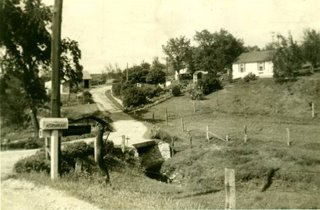 picking seasons.
picking seasons.The barn was used to store farm tools, provide shelter for the horse and cows, and allow hay to be kept protected in the loft. A small white chicken house was located close to the outhouse and further away from the hired man's one-room house. A pig shed completed the buildings on Grandma's farm.
Grandma's farm was mostly self-sufficient during the depression of the 1930s and during the rationing of essential items during World War II. They still needed to buy gasoline and tires for the truck to take produce to the City Market, electricity for lights and the cook stove, coffee, sugar for canning, clothes and shoes, and a few other things. But they had food, water, and a warm house with a wood stove. Grandma told me she could make bleach from wood ashes and also make soap from the lard of her pigs if she had to, but she usually bought these items. She was assisted in farming by a hired man and my Mother. During picking season, poor people were hired and paid by the box.
The major uncertainly was the weather. One spring the crops were planted and a freeze in mid to late May destroyed all the young plants. Everything had to be replanted and my Mother remembers that they produced very good crops for the rest of the summer.
Rainfall was problematic and I remember my Grandma and Mother (who helped Grandma with farming) praying many times for rain during periods of drought. Only the vegetables planted near the creek could be fairly easily watered during dry spells.
Children either went to a Catholic school or a much closer public school.
Small Family Farms in the Early 21st Century
Several Catholic families, each with a number of children, live west of Kansas City on acreage that ranges from several acres to about twenty acres. Taken as a whole, here are some of the elements that distinguish a small family farm in the 21st Century.
- The fathers all work at salaried or self-employed jobs with benefits (either paid for by self or by an employer). Most parents are well-educated.
- The family saved up sufficient money to buy land and a typically large house in the early years of marriage
- All the farms have barns; some shelter horses, cows, goats, and lambs, and store hay
- Farming is on a significantly smaller scale because mass production of animals and eggs means these products are often bought more cheaply than if they were raised
- The great majority of family food is bought, rather than raised, especially during non-harvest seasons and when fresh and frozen products are desired
- At least one family has a chicken house and raises chickens and eggs, although the reason for the chickens is simply to teach the children to work and be responsible
- Horse manure is picked up from the pasture and barn and used for garden fertilizer
- Homes are plumbed with water and waste systems (septic tanks)
- None of the houses have installed cisterns to trap and store water from rainfall on the roof
- Water is obtained from rural water systems
- New houses are well-insulated and heated using high-efficiency wood fireplaces and propane furnaces
- Houses have refrigerators and freezers to store food
- Air conditioners are used during hot periods
- Inside recreation consists of CD and DVD players and electronic games
- Cooking stoves are propane or electric
- Horses are not used as draft animals but for recreation
- Gasoline powered tools are the norm, including lawn tractors
- Gasoline and propane are often purchased in quantity and stored on the farm
- A limited number of berries, vegetables, and fruits are raised for home consumption but are not sold for money
- Trees and plants are irrigated during droughts
- Garage sales and Ebay are patronized for clothes, shoes, house items, toys, etc.
- Families often share children's clothes and expensive equipment with each other
- Labor for the farm is supplied, not by hired hands, but by parents and their children.
- Outdoor family recreation on the farm includes playing in creeks and barns, catching crawdads and minnows, riding horses and 4-wheelers, swimming in large plastic pools, jumping on trampolines, and shooting BB guns and arrows
- One family has installed wind turbines and solar cells to generate electricity that is stored in over a ton of lead acid batteries; In most periods, this family is able to provide electricity for all their home needs
- Children are almost all home-schooled.





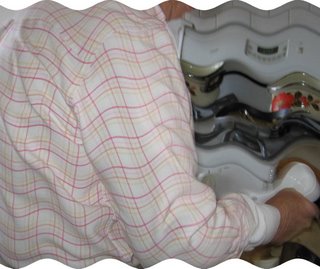
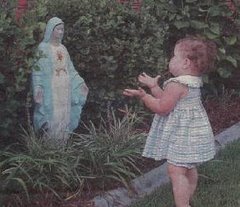
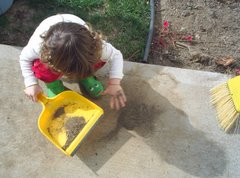
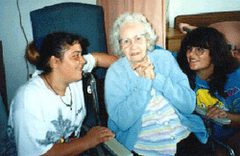
3 comments:
I used to receive the Small Farmers Journal, compliments of a friend. Yes, I am aware that a small number of hardy folks live almost completely the old way, especially without electricity.
Even though the people I described actually live quite modern lives, they have set themselves up as potentially being very self-reliant with the requisite acreage, some animals, garden, orchard, house with wood heating system, and limited farming skills. They are prepared to survive a natural or man-man disaster much longer than folks in the city.
I think the biggest obstacle to family farming right now is government regulation. My father bought 60 acres of good land, a barn and milked 30 dairy cows for 10 years. He did his own haying and spread manure over the fields. He go up at 4:30am to milk then went to work as an engineer all day, returned home, milked again finishing up around 8:30pm Then it was dinner and bed. From the time he began milking he price of milk dropped in half and the killer was that the state passed a regulation that manure could not spread on the fields. A $20,000 manure pit had to be built. This kiled most of the small family farms. People laugh at anti-environmentalist sentiment but their agenda is the same as the communists- to make it illegal for people to raise their own food.
The simple point is that the life your grandmother lived would be impossible under the current economic and regulatory circumstances. My family and I currently live like the modern families you discuss. I don't call this farming. It's more like being in the ex-urbs. We, and these other families, are making a choice to raise their children the best way we can find. However, when (not if) the economy takes a serious downturn, we will be better able to weather it than many others, who are dependent on the systems of the economy to survive. If neccesary, I could raise all of my family's food and fuel on these ten acres, with some to spare for sale to others. The reason I don't is simply that it is more profitable, and gives us a better standard of living, to work off the farm than to try eke a living out of it. If oil ever goes over $120 per barrel and stays there, you'll start to see the resurgence of the family farm in America.
Post a Comment